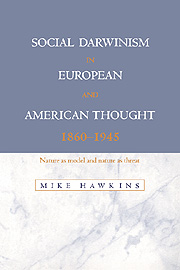Introduction
Sexual – like racial – characteristics have visible manifestations capable of being ordered and classified, read as symbols for other differences, and assigned values. Concern with such characteristics, both physical and mental, and with their meaning, have a long pedigree in Western thought. What invested this concern with particular urgency from the mid-nineteenth century on was the interface of two processes: political agitation for female emancipation and a reinterpretation of nature.
The growth of movements throughout Europe and the USA dedicated to the extension of civil and political rights to women created an intense interest in what became known, both to sympathisers and opponents, as the ‘Woman Question’. These movements challenged prevailing notions of the appropriate division of labour between the sexes and in so doing raised issues about the respective ‘nature’ of men and women and the extent to which these natures were biologically or culturally determined. Feminism, therefore, posed a comprehensive and disturbing challenge in ways not matched by class or even racial issues. As Cynthia Eagle Russett has argued, it not only encompassed education, occupation and legal issues, but intruded into such intimate areas as personal and matrimonial relationships.
The debate was complicated by the fact that while nature often acted as a court of appeal for the protagonists, the understanding of nature was itself undergoing a transformation. There was a long-standing tendency – general if not universal – to personify nature as a female, as at once both a physical and spiritual presence, nurturing, caring and erotic. But this imagery, as much a conception of femininity as of nature, had been undergoing revision even prior to the publication of the Origin.
